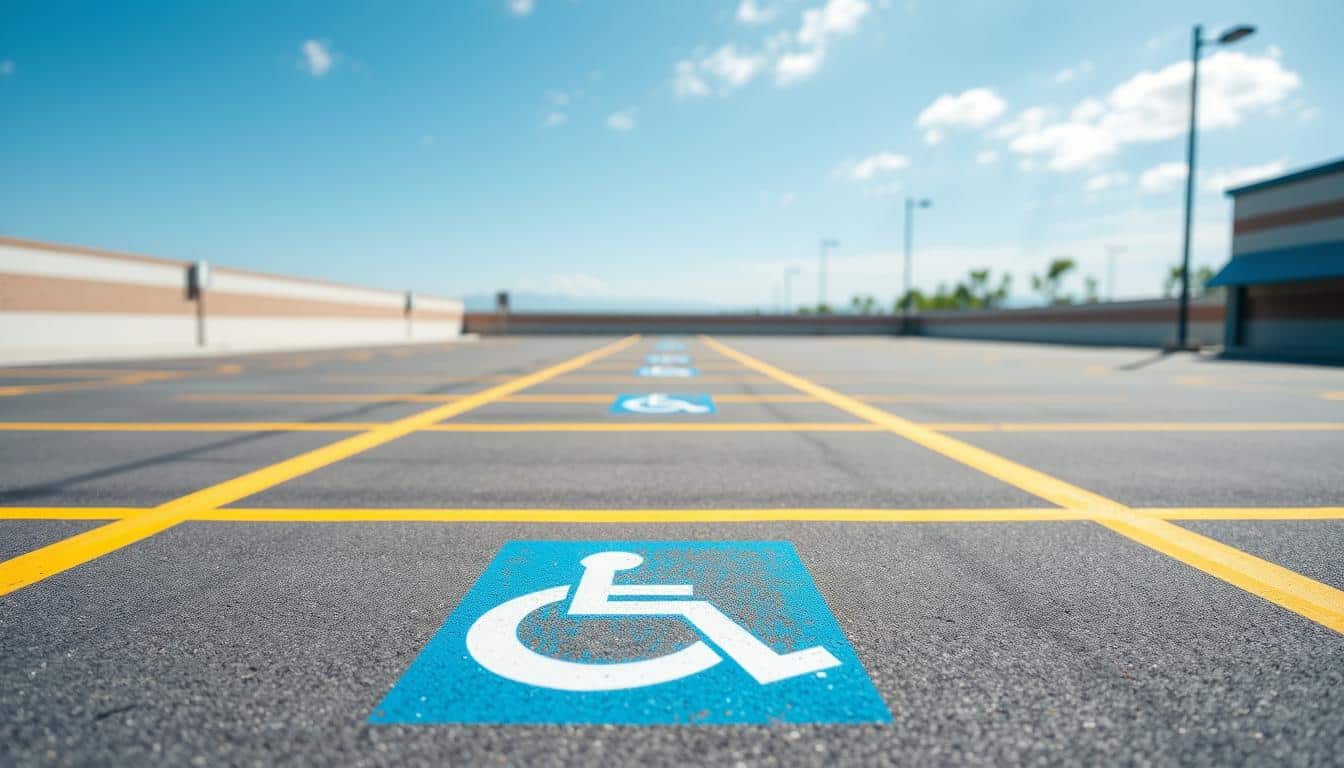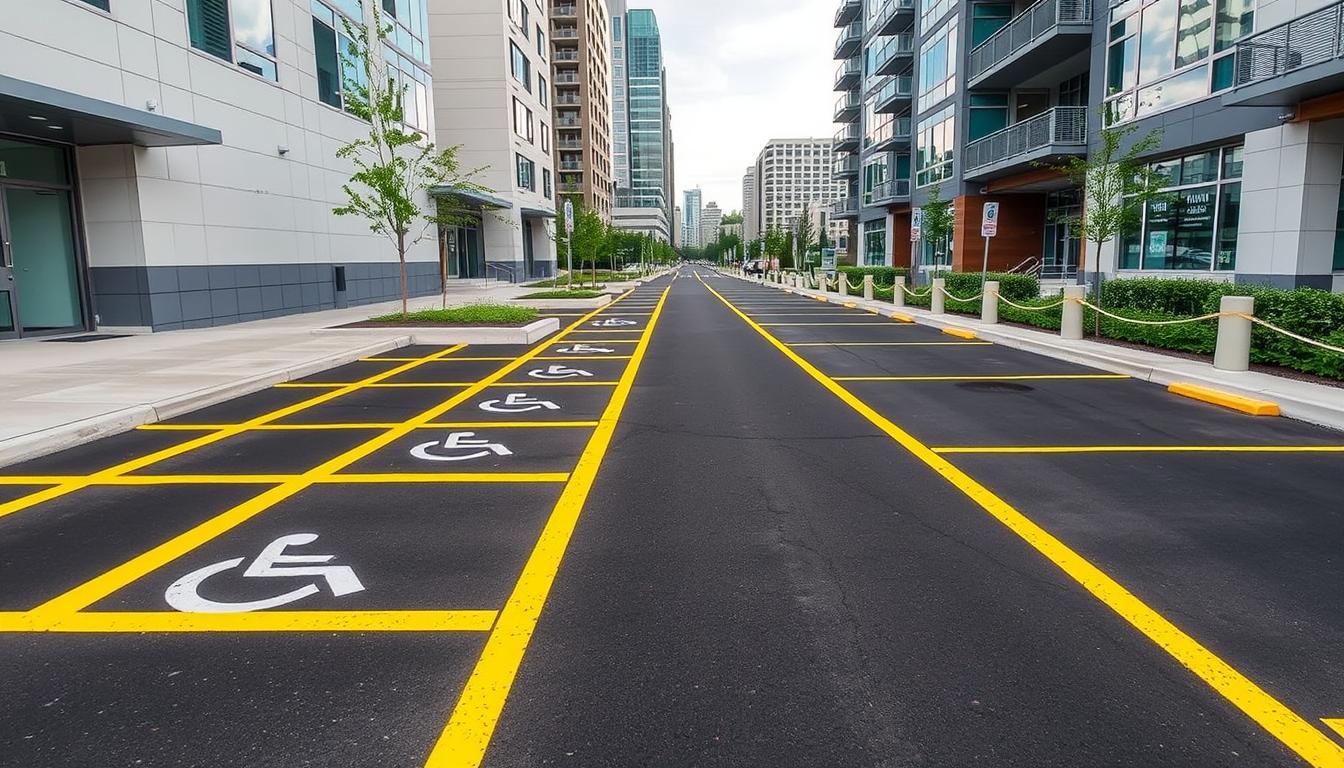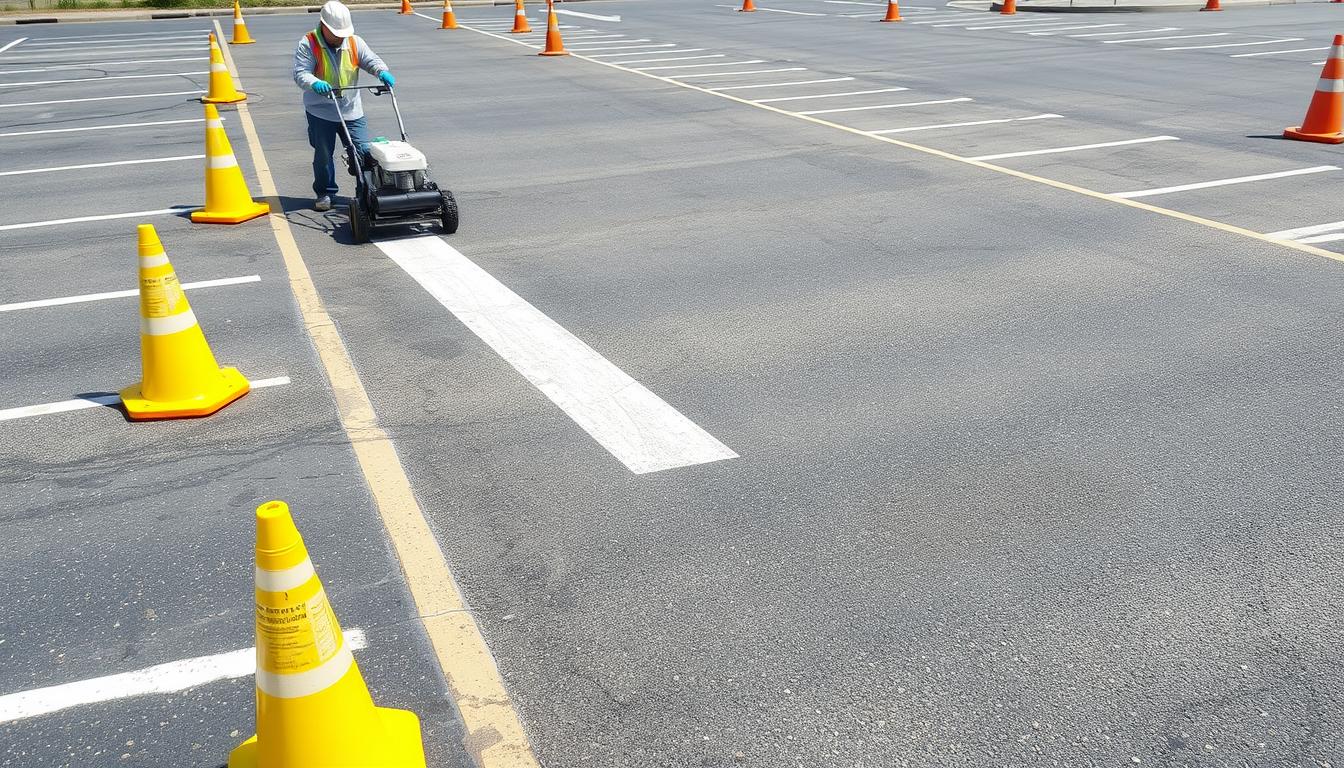Ever thought about How Do I Ensure Compliance With ADA Guidelines in Striping? It’s not just about painting lines. It’s about making a space welcoming for all. The Americans with Disabilities Act (ADA) has rules for public and private areas. These rules help make sure everyone can get around easily.
In this article, we’ll explore the important steps and best practices for ADA striping compliance. We’ll show you how to make your spaces not just legal but also open to everyone.
Key Takeaways
- Understanding ADA guidelines is essential for creating accessible environments.
- Compliance can have significant legal and financial consequences for businesses.
- Correct striping involves specific dimensions and signage requirements.
- Regular maintenance is key to maintaining compliance with ADA standards.
- Hiring professionals ensures adherence to the latest ADA regulations.
Understanding ADA Guidelines for Striping
The Americans with Disabilities Act (ADA) has important rules for making public spaces accessible. This includes parking lot striping. These rules cover the size, layout, signs, and markings needed for accessible paths. They help people with disabilities get to places as easily as others.
Definition of ADA Guidelines
ADA guidelines set the rules for making parking areas accessible. For example, they say how many accessible parking spots are needed. A small parking lot needs one accessible spot, while a bigger one needs two.
Accessible parking spots must be at least 96 inches wide. They should be along the shortest path to the building’s entrance. Businesses looking to follow these rules can find helpful tips on striping ADA compliance tips.
Importance of Compliance
Following ADA guidelines for striping is more than just following the law. It makes places more welcoming and accessible to everyone. Not following these rules can lead to big fines and legal costs.
It can also hurt a business’s reputation. So, making sure parking lots are accessible is key to treating all customers fairly.
Key Benefits of ADA Compliance
Following ADA guidelines for striping has many benefits. It makes customers happy and attracts more people. This is because people with disabilities look for places that are easy to get to.
It also protects businesses from expensive fines. By following these guidelines, companies show they care about everyone. This makes the community a better place for all.
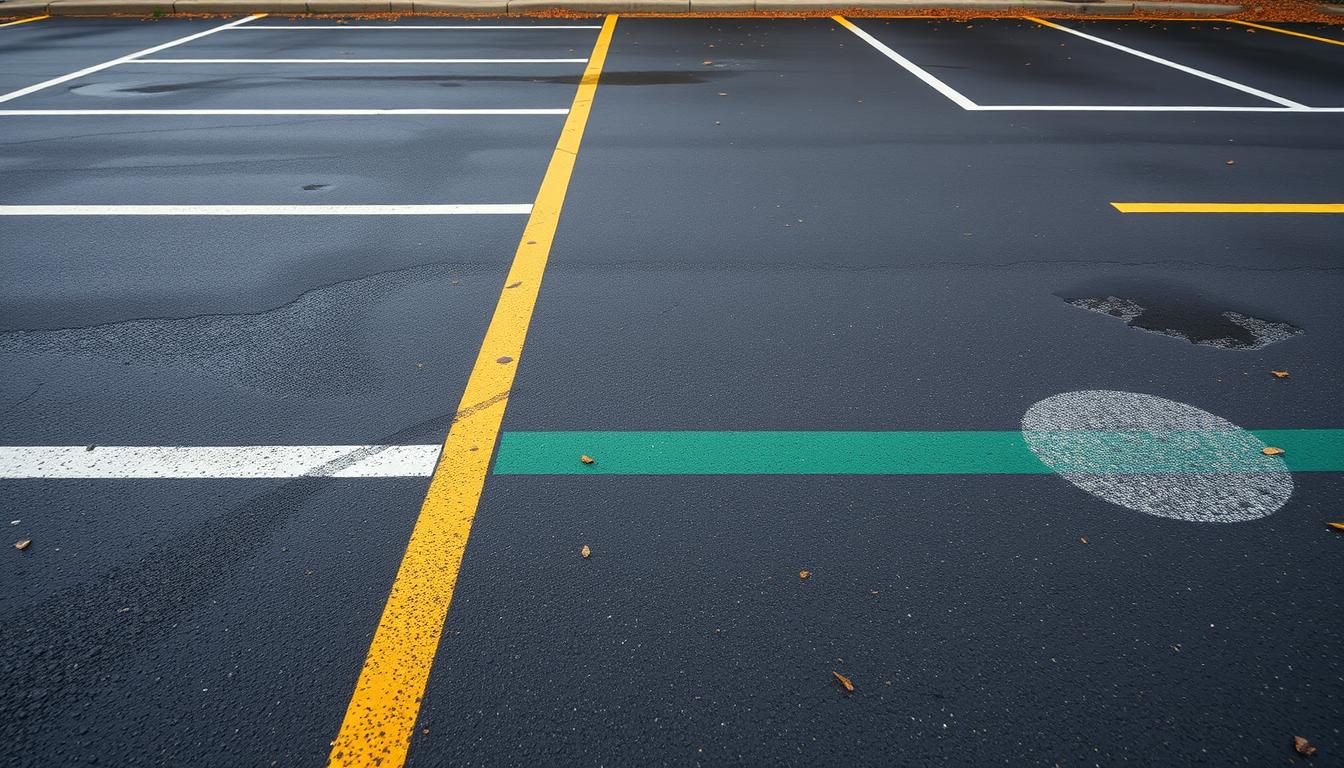
The Role of HT Paving and Seal Coating Services
At HT Paving and Seal Coating Services, we focus on making places accessible. We know how important it is to follow ADA guidelines for striping. Our goal is to go beyond what’s required to ensure safety and accessibility.
Our Commitment to Accessibility
We take accessibility very seriously. We follow ADA-compliant striping rules closely. Our team makes sure all markings are clear and easy to see. This makes places safer for everyone, no matter their abilities.
Expertise in Striping Services
Our team at HT Paving is well-versed in ADA rules and local striping laws. This knowledge helps us offer solutions that fit our clients’ needs. We use top-notch materials for our work, ensuring it lasts and meets ADA standards.
Customer-Centric Approach
We put our customers first, aiming to exceed their expectations. We work with clients to create solutions that focus on safety and accessibility. By understanding each project’s unique needs, we craft effective striping plans. This shows our dedication to quality and customer happiness.
Essential Requirements for Parking Lot Striping
Knowing what’s needed for parking lot striping is key for ADA compliance. It ensures accessible parking spots meet the rules, helping those with disabilities. Following ADA striping best practices helps everyone who visits.
Width of Accessible Spaces
Accessible parking spots must be at least 96 inches wide. Van-accessible spots need a 96-inch access aisle. This makes it easy for people with mobility issues to get in and out.
In California, lots with 1 to 25 spaces need one accessible spot. Lots with 501 to 1,000 spaces need 2% of spots to be accessible. Following these rules helps avoid big fines.
Signage and Marking Standards
Every accessible spot must have the International Symbol of Accessibility clearly shown. The markings should be clear and show what the space is for. Signs must be at least 60 inches up from the ground.
Access aisles need “No Parking” signs in 12-inch-high letters. This keeps the aisles clear. Following these guidelines makes sure everyone can access the spaces easily.
Van-Accessible Space Requirements
At least one van-accessible space is needed for every six accessible spots. For lots with over 200 spots, there must be at least two van-accessible spots. Each van-accessible spot needs a 96-inch-wide access aisle.
Meeting these requirements helps everyone, not just those with disabilities. It makes parking lots more inclusive for all.
Regulations on Pathways and Access Routes
Ensuring accessible pathways and access routes is key to ADA guidelines. Clear paths help people move easily with mobility devices. This part covers the important details for ADA compliance in striping.
Clear Pathway Specifications
Paths must be free from obstructions. They need a minimum width of 36 inches for easy movement. The surface should be level and even to avoid tripping hazards.
Importance of Curb Ramps
Curb ramps are essential for connecting paths with roads. They ensure safe transitions from the street to walkways. Curb ramps follow ADA guidelines, making public spaces safer and more accessible.
Surface Requirements
Surfaces must be stable, firm, and slip-resistant for ADA compliance. This ensures safe footing for mobility devices in all weather. Regular checks help keep surfaces in good condition, meeting ADA standards.
Choosing the Right Colors for Striping
Choosing the right colors for striping in parking lots is key. It ensures ADA rules are followed and makes it easier for everyone to see. Things like color contrast, visibility, and the environment play big roles in these choices.
ADA Recommended Color Contrast
High-contrast colors are a must for better visibility. White and yellow are top picks for dark surfaces. They make accessible areas and paths clear for everyone.
Visibility Considerations
Reflective paints boost safety, mainly at night or in bad weather. They help drivers and pedestrians see better. Using durable materials keeps things visible for a long time, keeping everyone safe.
Environmental Factors
Think about the environment when picking paint. Weather-resistant paints keep colors bright without needing to repaint often. This is good for the planet and keeps parking lots looking great.
Common ADA Compliance Mistakes
It’s key to know common ADA compliance mistakes to ensure parking lots are accessible. Many businesses miss important details, leading to legal and financial troubles. Knowing these mistakes helps companies meet ADA standards and create a welcoming space.
Misjudging Space Dimensions
Getting the measurements right is critical for accessibility. If spaces are too small, it causes problems and can lead to big fines. Making sure everything fits the ADA rules helps avoid these issues and makes spaces more useful.
Ignoring Proper Signage
Clear signs are essential for accessible parking. Without them, people might park in the wrong spots, making it hard for those who need them. Businesses must make sure signs are clear and visible to follow the rules and be inclusive.
Failing to Maintain Accessibility
Keeping spaces accessible is not just a one-time job. It’s important to check and fix things regularly. This keeps signs and paths clear and avoids legal problems. Not doing this can hurt a business’s image and lead to expensive fines.
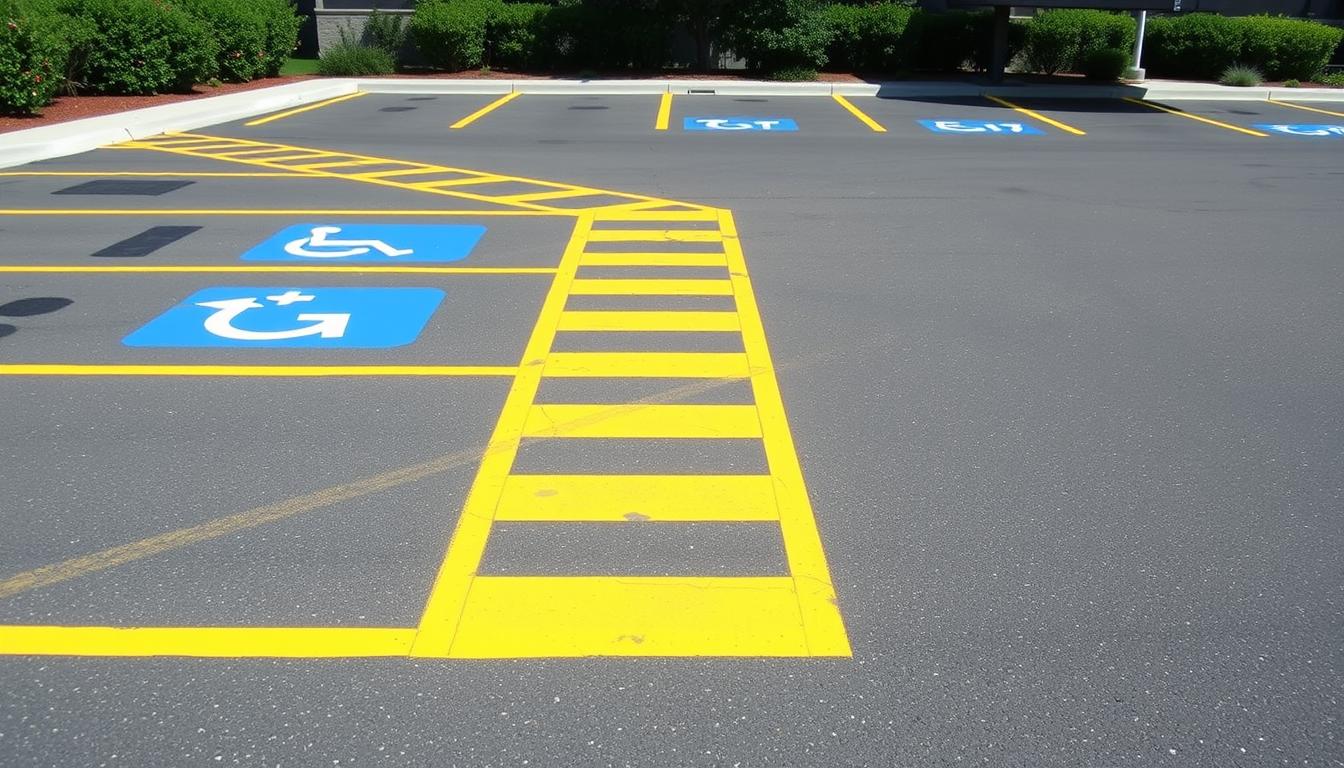
The Process of Ensuring Compliance
Ensuring ADA striping compliance starts with a detailed check of current layouts. This step aims to find areas needing improvement or changes. These changes help meet ADA guidelines for striping compliance.
Initial Site Assessment
The first step is the initial site assessment. A thorough check is done to see how the current layouts match ADA standards. This is key to finding areas that need adjustments to meet accessibility needs.
Designing the Striping Plan
After the site assessment, designing the striping plan comes next. This plan is carefully made to ensure all ADA requirements are met. It includes specific elements like width, visibility, and color contrast for easy navigation.
Execution and Quality Control
The final step is executing the striping plan. It’s important to pay close attention to detail during this phase. High-quality materials and markings that follow all regulations are used. A quality control process is followed to check for durability, visibility, and ADA compliance.
Maintenance of Striping for ADA Compliance
Keeping striping up to date is key for safety and access in public areas. Regular checks on ADA striping ensure a safe and compliant environment. A good maintenance plan helps keep markings clear and visible, improving the experience for all users.
Regular Inspections
Regular checks of accessible areas are vital. They help spot issues like poor visibility and damage. Ignoring these can lead to safety risks and legal problems. Also, they catch paint wear and tear early, preventing bigger issues.
Repainting and Updates
Markings fade over time, needing fresh paint to stay visible. Quick repainting keeps safety and ADA rules in check. It also helps avoid fines for not following new rules.
Keeping Up with Regulations
Staying on top of ADA rules is essential. It keeps facilities safe and efficient. Places that keep their striping up to date see fewer accidents. It’s important to know about rule changes to avoid legal trouble and fines.
The Importance of Hiring Certified Professionals
Following ADA guidelines is complex and requires deep knowledge. It’s vital to hire certified experts for striping and accessibility. Working with HT Paving brings many benefits for successful projects.
Benefits of Working with HT Paving
HT Paving is dedicated to following ADA standards. Their team handles each project carefully, lowering the chance of legal issues. In the U.S., nearly 40% of ADA lawsuits start in California. Ignoring ADA laws can cost a lot. Fines can be over $4,000, plus legal fees.
Quality Assurance Practices
HT Paving follows strict quality checks in their work. They aim to meet and often beat expectations. California’s ADA laws are strict, requiring precise attention to detail. This focus ensures top-notch results and avoids legal problems.
Customer Satisfaction Commitment
HT Paving puts customer happiness first. They know ADA lawsuits can cost $20,000 to $25,000. Their goal is to protect clients from these risks. They offer clear communication and custom services for all clients. This ensures every project is done right.
Contact HT Paving for Your Striping Needs
HT Paving provides customized solutions for ADA striping needs. We tailor our services to meet each client’s unique requirements. Our team works hard to make your spaces both functional and compliant. We focus on precise measurements and high-quality materials. Every detail of our striping services is designed with accessibility in mind.
Customized Solutions for Every Client
Our services are perfect for shopping centers or corporate facilities. We ensure you meet ADA standards with our tailored solutions. Each project’s specific needs are addressed for optimal accessibility and user satisfaction. Our solutions fit various property types. They promote inclusivity and follow regulations.
Service Area Information
HT Paving serves the Bay Area and surrounding California regions. We offer a wide range of striping services with a focus on quality and compliance. Our experienced team can handle projects of all sizes and complexities. We ensure accessible solutions for all communities.
Get In Touch: (415) 774-6424
Need expert help? Call us at (415) 774-6424 for more on our ADA-compliant striping services. Our team is ready to assist with all your striping needs. We ensure your parking solutions are effective and meet ADA standards.
